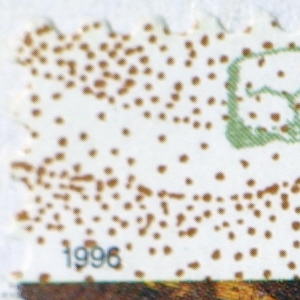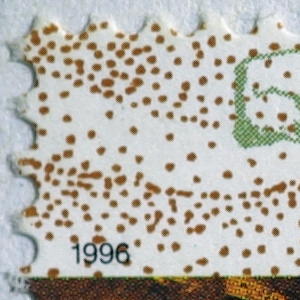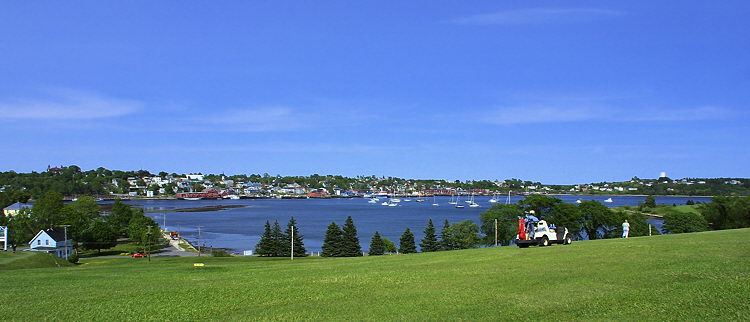
(The $85 Wonder)
Canon manufactures a huge selection of lenses for its EOS 35mm SLR cameras, costing anything from $85 to $50,000+. The cheapest of these is the humble, standard focal length, 50/1.8 Mark II. It also just happens to be a superbly sharp lens, one of the sharpest in their vast stable, even though plasticky in build. Below we are going to have a quick look as to what is possible with such a humble lens by taking rather extreme images. The particular lens I have used for the examples below is the old, all-metal Mark I, now no longer being manufactured. It used to cost more than the new Mark II does, but the optical quality is similar. So the current version should produce similar results. It is simply a fantastic bargain! Firstly, to dispel the myth that you need a macro lens to take extreme close-ups. The photo below was taken on an EOS D30 with a couple of extension tubes, adding up to 52mm extension, and the Mighty 50/1.8. Since everybody sooner or later takes a photo of a hibiscus, I thought it would make a fitting example. But since everyone tends to shoot red ones I decided to try out a white one this time :-) Taken with an off-camera, back-lighting flash, to get a bit of a glow, at f/22, for generous depth of field. Well, as generous as one can get at these macro distances.

Let's now go for something on a totally different distance scale. How about a galaxy that's a zillion km away, actually 2.3 million light years away, the Great Galaxy in Andromeda. I do not know what a zillion is, but this galaxy, also known as Messier 31, or M31, is some 22 trillion km from us. At a dark sky site, and if you know exactly where to look, you can just about make out the very faint, hazy glow of the central core of this galaxy. It is often stated that this is the furthest object that can be seen by the naked eye. Far enough for the Mighty 50/1.8? Indeed, who says you need to use a telescope to photograph galaxies?! The lens was mounted on an astronomical CCD (SBIG 237) and 60 exposures each 30 seconds long were stacked up. Even this effectively 30 minute exposure @ f/1.8 was not long enough to overcome the light pollution at my rooftop satisfactorily. But nevertheless the Mighty 50/1.8 did a reasonable job.

Next let us see how sharp the Mighty 50/1.8 is compared to possibly the sharpest lens I own, the Canon 100/2.8 macro. This is the old nonUSM version. I took two photos of the stamp below, one with the Mighty 50/1.8 + extension tubes, and another with the 100/2.8macro. Photo below is a full-frame D30 image:

followed by 1:1 crops (centre) first by Mighty 50/1.8 (left) and then (at right) by the 100/2.8macro, both lenses at their optimal aperture, f/8


As you can see, that little standard lens certainly holds up! With enough imagination one can even perceive it as slightly sharper than the macro, centrally. However, below are 1:1 crops from the corners:


OK, now you know why the macro costs so much more. It gives a flat field and is sharp all over, not just centrally. What next after macros and galaxies? What about going ultra wide? Let's compare it with a really wide angle lens, a 14mm. Here is a photo of Lunenburg, Nova Scotia, taken with a Tamron 14mm f/2.8 lens on the EOS D30:

Looks nice and panoramic. But let us go down near the water, even closer to the harbor scene and restrict ourselves to using the Mighty 50/1.8. How about this one below for a panorama effect?

Did you scroll right? OK, a bit of cheating involved. I stitched together 13 frames taken by the Mighty 50/1.8 and covered a scene that was way more than 180 degrees, certainly wider than in the previous 14mm photo. Noticed the small road appearing on both ends of the panorama? Actually I was trying to do a full 360 degree panorama, but since I was shooting handheld, I messed up a bit on the remaining frames and ended up with a chunk missing. As for resolution on the unreduced images, there is simply no comparison between a single 14mm frame (2160 pixels wide) and the multi-frame stitch using the 50mm (19,407 pixels wide!). So, message to all owners of Canon EOS cameras: Do not disdain that little $85 lens! You can use it to shoot macros, galaxies, panoramas, and all the usual everyday stuff. Have fun ;-)
For more stuff return to Samir's Home
To drop me an e-mail just
click on:
samirkharusi